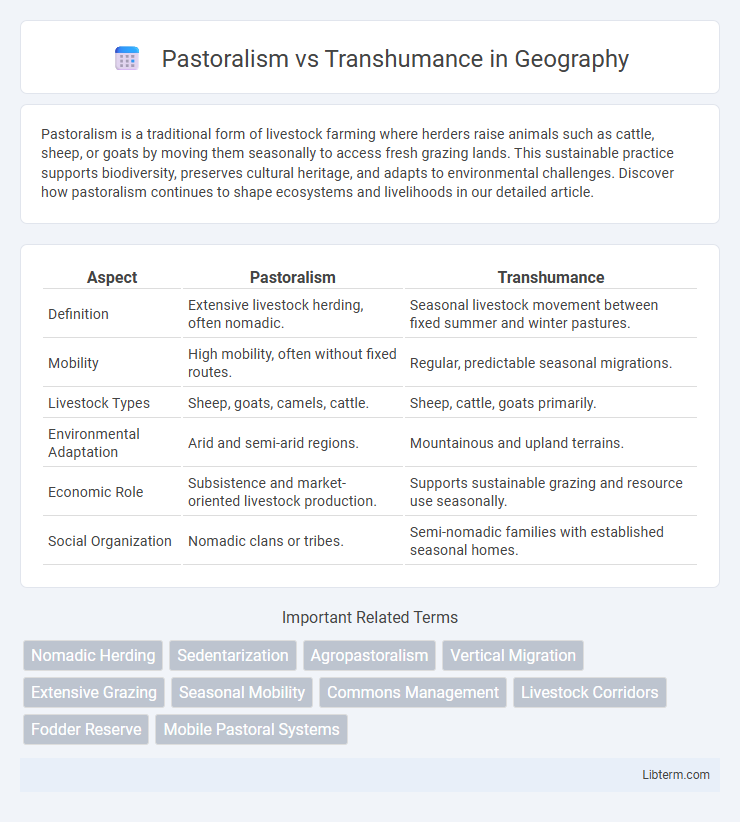Pastoralism is a traditional form of livestock farming where herders raise animals such as cattle, sheep, or goats by moving them seasonally to access fresh grazing lands. This sustainable practice supports biodiversity, preserves cultural heritage, and adapts to environmental challenges. Discover how pastoralism continues to shape ecosystems and livelihoods in our detailed article.
Table of Comparison
| Aspect | Pastoralism | Transhumance |
|---|---|---|
| Definition | Extensive livestock herding, often nomadic. | Seasonal livestock movement between fixed summer and winter pastures. |
| Mobility | High mobility, often without fixed routes. | Regular, predictable seasonal migrations. |
| Livestock Types | Sheep, goats, camels, cattle. | Sheep, cattle, goats primarily. |
| Environmental Adaptation | Arid and semi-arid regions. | Mountainous and upland terrains. |
| Economic Role | Subsistence and market-oriented livestock production. | Supports sustainable grazing and resource use seasonally. |
| Social Organization | Nomadic clans or tribes. | Semi-nomadic families with established seasonal homes. |
Definition of Pastoralism
Pastoralism is a livelihood system centered on the domestication and herding of livestock for food, fiber, and other resources, typically involving continuous or seasonal movement to access grazing areas. It differs from transhumance, which specifically refers to the seasonal movement of herders and their animals between fixed summer and winter pastures. Pastoralism encompasses a broader range of animal husbandry strategies, including both nomadic and semi-nomadic practices.
Definition of Transhumance
Transhumance refers to the seasonal movement of livestock between fixed summer and winter pastures, often involving long-distance migrations across varied terrains. This practice contrasts with general pastoralism, which encompasses all forms of livestock herding and grazing, including sedentary, nomadic, and transhumant systems. Transhumance is specifically characterized by its predictable, cyclical nature tied to climatic and ecological conditions.
Historical Roots and Origins
Pastoralism, with origins dating back to the Neolithic era around 10,000 BCE, emerged as humans transitioned from hunting-gathering to animal domestication in regions such as the Fertile Crescent. Transhumance, a specialized form of pastoralism, has historical roots in Mediterranean and mountainous societies where seasonal movement between fixed summer and winter pastures optimized grazing resources. Both practices played crucial roles in shaping early agricultural economies and human settlement patterns across Eurasia and Africa.
Livestock Management Practices
Pastoralism involves the continuous grazing of livestock over large areas, adapting herd movements to seasonal and environmental conditions to optimize forage use. Transhumance is a specialized form of pastoralism where herders seasonally move livestock between fixed summer and winter pastures to exploit altitude-related climatic variations. Both practices emphasize sustainable management of grazing resources, but transhumance integrates strategic vertical mobility to enhance pasture regeneration and animal nutrition.
Seasonal Movement Patterns
Pastoralism involves the continuous, often local, movement of livestock within a defined area to access grazing resources, while transhumance is characterized by the predictable, seasonal migration of herds between fixed summer and winter pastures. In transhumance, livestock are typically moved to highland pastures during summer and returned to lowland areas in winter, optimizing forage availability in distinct ecological zones. Pastoralism's movement patterns are more flexible and responsive to immediate environmental conditions, whereas transhumance follows established migratory routes aligned with seasonal climate variations.
Socioeconomic Impacts
Pastoralism supports steady livelihoods by enabling communities to rely on livestock for food, income, and cultural identity, fostering economic stability. Transhumance involves seasonal livestock migration, which promotes resource optimization and trade networks but can also lead to conflicts over land use and access rights. Both systems influence social structures and local economies, with pastoralism often favoring settled communal cooperation and transhumance encouraging mobility and broader market integration.
Environmental Sustainability
Pastoralism involves continuous grazing of livestock over large permanent areas, which can lead to overgrazing and land degradation if not managed properly, impacting environmental sustainability negatively. Transhumance, characterized by seasonal movement of herds between fixed summer and winter pastures, allows for natural regeneration of grazing land and biodiversity conservation, promoting more sustainable ecosystem management. Both practices require adaptive management strategies to balance livestock productivity with soil health, water resources, and habitat protection in fragile environments.
Cultural and Traditional Aspects
Pastoralism and transhumance both represent traditional livestock herding practices deeply embedded in cultural identities across various regions. Pastoralism involves the continuous movement of herds within a fixed territory, reflecting longstanding customs and social structures tied to specific landscapes. Transhumance specifically entails seasonal migration between fixed summer and winter pastures, preserving rituals, oral histories, and communal knowledge associated with cyclical environmental changes.
Modern Challenges and Adaptations
Pastoralism and transhumance face modern challenges such as climate change, land degradation, and restricted grazing areas due to urbanization and agricultural expansion. Nomadic herders adopt adaptive strategies like diversifying livestock, integrating technology for herd management, and engaging in community-based resource governance. These adaptations aim to sustain livelihoods while mitigating environmental impacts and securing access to essential grazing corridors.
Comparative Analysis: Pastoralism vs Transhumance
Pastoralism involves the continuous raising and herding of livestock within a specific area, emphasizing sedentary or semi-nomadic practices, while transhumance is a seasonal migration strategy where herders move livestock vertically between fixed summer and winter pastures. Pastoralism supports diverse ecosystems by maintaining grazing lands year-round, whereas transhumance optimizes resource use by exploiting spatial and temporal variations in pasture availability. Both strategies ensure livestock survival and ecological balance, but transhumance relies more heavily on predictable climatic patterns and landscape mobility.
Pastoralism Infographic

 libterm.com
libterm.com